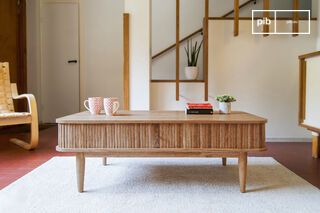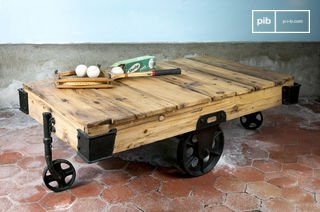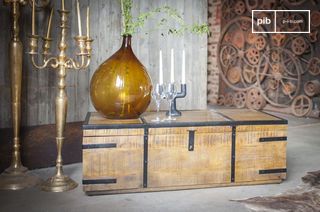Beige coffee tables
Beige coffee tables introduce a light, neutral volume into the center of the living room. Their subdued hue allows a fluid transition between more visually striking elements, without creating a break. A beige coffee table is equally at home in a tone-on-tone environment or in a contrasting arrangement, playing a balancing role. Light wood, ceramic, reconstituted stone or tinted resin: the materials vary, but the logic remains the same. Beige supports without dominating.
read more >Filters

Oak side table with curtainsRitz
€595 €535-10%

Wooden Coffee TableWood Wagon
€725 €655-10%
Functions and perception of a beige coffee table
A beige coffee table provides a neutral focal point in a dense composition. Its hue, neither cold nor bright, allows easy cohabitation with contrasting materials or strong colors. It doesn't impose visual direction, but supports the overall balance of the space. In a bright living room, it extends the palette without generating saturation. In a more structured environment, it attenuates mass effects.
Beige does not refer to a single color, but to a spectrum of hues: sand, linen, light clay, cream. Each of these shades produces a slightly different effect depending on light, material and context. A beige coffee table thus becomes a contrast regulator, particularly useful in living rooms with varied textures or multiple volumes. It also preserves overall legibility without rigidifying the composition.
Materials, formats and finishes
The materials used for beige coffee tables are chosen as much for their visual effect as for their behavior over time. Light or beige-stained wood gives a matte, natural finish, suitable for frequent use. Reconstituted stone, ceramics or mineral resins offer dense, smooth or porous surfaces, depending on the finish. Beige-painted metal creates lightweight structures with a coherent tonality. Some finishes adopt a raw or mineral look, while others opt for a smooth or satin finish. This choice impacts the way light is distributed over the surface and the way the table dialogues with the other materials in the living room.
Sizes follow design needs: A rectangular or oval top to accompany linear seating. A round or square shape to organize circulation around the center. Stackable or combinable modules to adapt the usable surface to the time of day. Beige lends itself well to these variations, as it remains legible whatever the geometry adopted.
Agency, light and spatial articulation
The beige coffee table fits into a wide variety of configurations, depending on natural light, walls and floors. It acts as a transitional surface: between a dark sofa and a light carpet, between a warm parquet floor and a cool fabric seat, between a neutral wall and a structured bookcase. This mediating function relies on its shade, but also on its shape, height and finish.
In rooms with high light exposure, a matte or micro-textured finish avoids overly visible reflections. In darker spaces, a slightly warm beige can counterbalance the dombre or mass effect. The aim is not to create a focal point, but to organize the reading of space without forcing it. A beige coffee table can also serve as a support for more contrasting objects (black books, metal objects, colored textiles), without these elements taking over the overall composition.
Choosing a beige coffee table means opting for a discreet but structuring anchorage. It doesn't seek to mark the space, but to make it more legible. Its neutrality is active: it makes equilibrium possible, without visually imposing.
It's the perfect complement to the table
